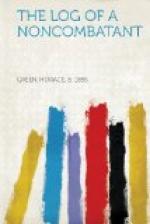From Maastricht to the Dutch capital is, under usual conditions, a four-hour run to the north. During this trip we passed encampments and fortifications of the 400,000 well-drilled but poorly equipped troops which the Kingdom of the Netherlands, in the spirit of no negative neutrality, had mobilized along her borders. Whenever we crossed a bridge every window in the entire train was fastened down and there were strict orders against raising them. We discovered that under the boulders were carefully concealed large charges of dynamite ready for immediate use in case of invasion—so that Horatius need not be called upon while axe and crowbar were at work. The windows, it appears, were locked to prevent throwing out of lighted cigars or matches.
At one o’clock the next morning our train, delayed by war-time traffic, rolled into the Hague station, whence three days later, I was to start my lucky trip into Antwerp, the besieged.
Clog dancing and cognac helped to get me from The Hague back into Antwerp in time for its bombardment and capture by the German forces under General von Beseler. I happened to perform the clog dancing at a critical moment during a trip on a Scheldt River barge, thus diverting the attention of the river sentries from my lack of proper papers. While the pedal acrobatics were in progress my temporary friend, Mons. le Conducteur, reinforced the already genial pickets with many glasses of the warming fluid.
Willard Luther, my companion in and out of jail during the first part of the continental wanderings, was forced to leave for home the day after we got back to The Hague. He had five days to catch the Lusitania at Liverpool. Three of them he spent on a whirlwind trip trying to see action in northern Flanders, but, much to his disappointment, was called away before the final scrimmage at Antwerp. If he had succeeded in getting in, I rather fear the Massachusetts Bar would have lost a valuable member. He had an insatiable passion to be in the neighborhood of bullets and bombs— not, as I take it, that he really wanted to get hit—merely that he would like to see how close he could come.
On October 2d, strictest regulations were passed prohibiting entry within the fortifications of Antwerp without permit from the military governor, General de Guise. Three weeks earlier entry had been possible but difficult, and the feat was again easier after the German occupation. But during the city’s days of trial the military lid was clamped and riveted. Except for those coming direct from England, the highest civil recommendations were valueless.
I had one of these,—a laissez-passer from Prince d’Eline, Secretary of the Belgian Legation at The Hague,—issued because of the fact that I was carrying a large packet of mail from the American Legation at The Hague to Henry W. Diederick, United States Consul-General at Antwerp. I had also been entrusted with three hundred marks to be delivered to a German prisoner, Lieutenant Ulrici, known to have been wounded and captured in the fighting around Termonde, and believed to be lying in a hospital ship in the river or in Antwerp itself. The fact of carrying such money was of course against me as indicating German sympathy.




